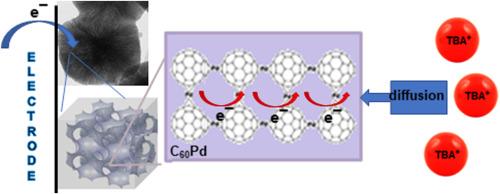有序介孔二氧化硅内部的C60Pd配位低聚物:形成、形态和电化学性质
IF 4.7
3区 材料科学
Q1 CHEMISTRY, APPLIED
引用次数: 0
摘要
本研究报道了有序介孔二氧化硅颗粒MCM-48的形成和表征,MCM-48用作支撑形成C60Pd@MCM-48纳米复合材料。通过毛细管作用将含富勒烯C60的苯溶液浸渍在二氧化硅纳米孔中,然后将该富勒烯掺入到二氧化硅孔中,在含有聚合过程前驱体的溶液中进行化学聚合。采用扫描电子显微镜、透射电子显微镜、原子力显微镜、能量色散x射线分析、红外光谱、氮吸附-解吸和热重法对复合材料的形貌和结构进行了研究。从复合材料中提取C60Pd聚合物,形成直径为2 ~ 3nm的球形纳米颗粒。C60Pd@MCM-48复合材料在正负电位范围内均表现出电化学活性。两个过程的速率和参与电化学过程的低聚物的数量由通过充满C60Pd相的二氧化硅孔的反离子传输控制。与直接沉积在电极表面的原始富勒烯聚合物相比,配位富勒烯低聚物与缺陷二氧化硅表面之间的相互作用导致C60Pd相更容易还原。本文章由计算机程序翻译,如有差异,请以英文原文为准。

C60Pd coordination oligomers inside ordered mesoporous silica: formation, morphology, and electrochemical properties
This study reports the formation and characterization of ordered mesoporous silica particles, MCM-48, used as supports to form C60Pd@MCM-48 nanocomposites. Silica nanopores were impregnated with a benzene solution containing fullerene C60 via capillary action, and then, this fullerene incorporated into the silica pores was chemically polymerized in a solution containing a precursor to the polymerization process. The morphology and structure of the resulting composite were investigated using scanning electron microscopy, transmission electron microscopy, atomic force microscopy, energy-dispersive X-ray analysis, infrared spectroscopy, nitrogen adsorption–desorption, and thermogravimetry. The C60Pd polymer was extracted from the composite and formed spherical nanoparticles with a diameter of 2–3 nm. The C60Pd@MCM-48 composite exhibited electrochemical activity both in positive and negative potential ranges. Rates of both processes and the amount of oligomeric material involved in the electrochemical process were controlled by counterion transport through the silica pores filled with the C60Pd phase. The interaction between the coordination fullerene oligomer and the defected silica surface led to the easier reduction of the C60Pd phase in comparison to the pristine fullerene polymer deposited directly on the electrode surface.
求助全文
通过发布文献求助,成功后即可免费获取论文全文。
去求助
来源期刊

Microporous and Mesoporous Materials
化学-材料科学:综合
CiteScore
10.70
自引率
5.80%
发文量
649
审稿时长
26 days
期刊介绍:
Microporous and Mesoporous Materials covers novel and significant aspects of porous solids classified as either microporous (pore size up to 2 nm) or mesoporous (pore size 2 to 50 nm). The porosity should have a specific impact on the material properties or application. Typical examples are zeolites and zeolite-like materials, pillared materials, clathrasils and clathrates, carbon molecular sieves, ordered mesoporous materials, organic/inorganic porous hybrid materials, or porous metal oxides. Both natural and synthetic porous materials are within the scope of the journal.
Topics which are particularly of interest include:
All aspects of natural microporous and mesoporous solids
The synthesis of crystalline or amorphous porous materials
The physico-chemical characterization of microporous and mesoporous solids, especially spectroscopic and microscopic
The modification of microporous and mesoporous solids, for example by ion exchange or solid-state reactions
All topics related to diffusion of mobile species in the pores of microporous and mesoporous materials
Adsorption (and other separation techniques) using microporous or mesoporous adsorbents
Catalysis by microporous and mesoporous materials
Host/guest interactions
Theoretical chemistry and modelling of host/guest interactions
All topics related to the application of microporous and mesoporous materials in industrial catalysis, separation technology, environmental protection, electrochemistry, membranes, sensors, optical devices, etc.
 求助内容:
求助内容: 应助结果提醒方式:
应助结果提醒方式:


